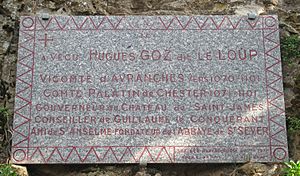Hugh d'Avranches, Earl of Chester facts for kids
Quick facts for kids
Hugh d'Avranches
|
|
|---|---|

|
|
| Born | c. 1047 Normandy
|
| Died | 27 July 1101 |
| Resting place | St Werburgh's Abbey, Chester |
| Other names | le Gros (the Large) Lupus (Wolf) |
| Title | Earl of Chester (2nd creation) |
| Term | 1071–1101 |
| Predecessor | Gerbod the Fleming, 1st Earl of Chester (1st creation) |
| Successor | Richard d'Avranches |
| Spouse(s) | Ermentrude of Claremont |
| Children | Richard d'Avranches |
| Parent(s) | Richard le Goz, Viscount of Avranches |
Hugh d'Avranches (born around 1047 – died July 27, 1101) was an important Norman leader in early England. People knew him by his nicknames: le Gros (meaning "the Large") because he was big, and Lupus (meaning "the Wolf") because he was fierce in battle. From 1071, he became the second Earl of Chester, a powerful position in England.
Contents
Early Life and Rise to Power
Hugh d'Avranches was born in Normandy around 1047. His father was Richard le Goz, Viscount of Avranches. Not much is known about his mother. Some stories say she was related to William the Conqueror, but this is not certain.
In 1071, the first Earl of Chester, Gerbod the Fleming, 1st Earl of Chester, was captured in a battle in France. The king decided that the title of Earl of Chester was now empty. Cheshire was a very important area because it was close to Wales. It was given special powers, like a mini-kingdom, called a county palatine. The king gave these powers and the earldom to Hugh.
As Earl, Hugh appointed many important people, including his cousins Robert of Rhuddlan and Nigel of Cotentin. He also received many lands that used to belong to Edwin, the last Saxon earl of Mercia.
After his father passed away, Hugh also became Viscount of Avranches around 1082. This meant he inherited many large estates across western Normandy. Hugh was friends with the religious leader St Anselm. He also helped start new religious places, like the Benedictine Abbeys of Sainte-Marie-et-Saint-Sever in Normandy and St. Werburgh in Chester. He also gave land to Whitby Abbey in North Yorkshire.
Hugh was always loyal to King William II during a rebellion in 1088. Later, he became one of the main advisors to King Henry I.
Battles in Wales
Hugh spent a lot of his time fighting with his neighbors in Wales. He worked with Robert of Rhuddlan to take control of much of northern Wales.
In 1081, Gruffudd ap Cynan, the King of Gwynedd, was captured. Earl Hugh imprisoned Gruffudd in his castle in Chester. Robert then took control of Gruffudd's kingdom.
When Robert was killed in 1093 by a Welsh raiding party, Hugh took over these lands. This made him the ruler of most of North Wales. However, he lost Anglesey and much of Gwynedd in a Welsh uprising in 1094. This revolt was led by Gruffudd ap Cynan, who had escaped from prison.
Norwegian Invasion
In the summer of 1098, Hugh joined forces with Hugh of Montgomery, 2nd Earl of Shrewsbury. They wanted to win back the lands they had lost in Gwynedd. Gruffudd ap Cynan had gone to Anglesey, but he was forced to flee to Ireland when a fleet he had hired changed sides.
However, things changed when a Norwegian fleet arrived. It was led by King Magnus III of Norway, also known as Magnus Barefoot. He attacked the Norman forces near the Menai Straits. Earl Hugh of Shrewsbury was killed by an arrow, which some say was shot by Magnus himself. The Normans had to leave Anglesey completely. Gruffudd, who had returned from Ireland, took control of the area the next year. Hugh then made an agreement with Gruffudd and did not try to take back those lands again.
Family and Legacy
Hugh d'Avranches married Ermentrude of Claremont. They had one son, Richard d'Avranches, 2nd Earl of Chester, who became his heir. Hugh also had other children outside of his marriage, including a son named Robert, who became an abbot.
Hugh became ill and, on July 13, 1101, he became a monk at his own religious foundation of St. Werburgh. He passed away there four days later, on July 27, 1101. His son Richard became the next Earl of Chester. Richard married Matilda of Blois, who was a granddaughter of William the Conqueror.
Sadly, both Richard and Matilda died in the terrible sinking of the White Ship in 1120. After that, the Earldom passed to Hugh's nephew, Ranulph le Meschin, Earl of Chester. Ranulph was the son of Hugh's sister, Margaret.
Hugh was remembered for his large size, which led to his nickname le Gros (the Fat). He was also called Lupus (Wolf) because of his fierce fighting style against the Welsh.
See also

